The response of Golgi protein 73 to transcatheter arterial chemoembolization in patients with hepatocellular carcinoma may relate to the influence of certain chemotherapeutics
Beijing, China
The response of Golgi protein 73 to transcatheter arterial chemoembolization in patients with hepatocellular carcinoma may relate to the influence of certain chemotherapeutics
Jie Pan, Ye-Fan Zhang, Hua-Yu Yang, Hai-Feng Xu, Xin Lu, Xin-Ting Sang, Shou-Xian Zhong and Yi-Lei Mao
Beijing, China
BACKGROUND: Golgi protein 73 (GP73) is a promising biomarker of hepatocellular carcinoma (HCC). It decreases after surgical resection, and resumes upon recurrence, indicating a potential indicator for the effectiveness of the treatment. But changes of GP73 after transcatheter arterial chemoembolization (TACE) have not been reported so far. This study was to investigate the dynamic changes of GP73 in HCC patients after TACE treatment, and the possible underlying mechanisms in the cell cultures.
METHODS: Blood samples were collected from 72 HCC patients, before TACE, at day 1 and day 30 after TACE. GP73 levels were measured by Western blotting. The dynamic changes of GP73 were analyzed and compared with image changes and clinical data. The effects of chemotherapeutic agents (5-FU and pirarubicin) on GP73 expression were tested in three HCC cell lines (HepG2, HCCLM3 and MHCC97H).
RESULTS: The GP73 level was signifcantly elevated at day 1 and day 30 after TACE in HCC patients compared with that before the procedure (P<0.05). There was no statistical difference between the two time points after TACE, nor correlationbetween GP73 levels and clinicopathological features, tumor metastasis, and patient survival. Pirarubicin, not 5-FU, signifcantly increased GP73 expression in three cell lines.
CONCLUSIONS: Unlike surgical resection which decreases the GP73 level, TACE signifcantly increased GP73 expression in patients with HCC. No correlations were observed among GP73 levels, tumor characteristics and prognosis of patients with HCC.
(Hepatobiliary Pancreat Dis Int 2015;14:406-412)
hepatocellular carcinoma;
transcatheter arterial chemoembolization;
Golgi protein 73;
chemotherapeutics
Introduction
Hepatocellular carcinoma (HCC) is one of the most malignant cancers in the world, with morbidity ranks the 5th and mortality the 3rd among various cancers.[1,2]Earlier diagnosis of HCC is essential for therapeutic selection. However, there is no accurate biomarker to diagnose and monitor the patients with HCC; traditional alpha-fetoprotein (AFP) has a limited role in HCC diagnosis and monitoring due to the lack of sensitivity and specifcity. Clinicians therefore are trying to fnd a better biomarker to be added to or replace AFP. Golgi protein 73 (GP73), a Golgi type II transmembrane protein, has been indicated as one of the most promising HCC serum markers that might be applicable in clinical practice. This protein is normally expressed in epithelial cells of tissues including bile ducts, intestinal tracts, trachea and prostate, and increased signifcantly in HCC patients.[3-6]A large sample, multi-center andmulti-nation clinical study[5]showed that the sensitivity and specifcity are 74.6% and 97.4% respectively for the diagnosis of HCC, which are signifcantly higher than those of AFP in the same cohort. More interestingly, serum GP73 value in HCC patients is correlated with tumor mass: surgical resection almost normalized serum GP73 and its value was rebounded upon tumor recurrence.[5]Our data implied its potential role in evaluating or monitoring the effectiveness of treatments for HCC. These treatments might include surgery, radiofrequency ablation, sorafnib, and transcatheter arterial chemoembolization (TACE) as recommended by the guidelines elsewhere. However, sporadic data up to date showed the changes of GP73 level after treatments of HCC other than surgical resection.
TACE is widely employed in patients with HCC, and has been recommended as the frst choice for the middle-advanced stage HCC patients who cannot accept surgery.[7,8]However, there is still lack of an effective way to evaluate the effcacy of TACE, whereas the changes of tumor size may not be reliable enough, and AFP is not sensitive.[9-11]
The present prospective clinical study was to observe the changes of serum GP73 after TACE at different time points, to investigate the correlations between the changes and the clinical prognosis, to see if GP73 could be a potential indicator to evaluate the effectiveness of TACE, and to study the underlying mechanisms of GP73 fuctuation in HCC.
Methods
Patients
Inclusion criteria
(1) Patients diagnosed with HCC based on either pathologic results or AFP and images as indicated by the guidelines;
(2) Patients with Child-Pugh A and large or multifocal HCC which were not suitable for surgical resection or radiofrequency ablation;
(3) Patients who underwent TACE as the initial treatment and had no history of surgery, ablation or chemical therapy;
(4) Patients included on a voluntary basis were able to actively have related test.
Exclusion criteria
(1) Liver function ranked Child-Pugh B and C;
(2) Active gastrointestinal bleeding;
(3) Impaired coagulation functions (platelet count below 50×109/L or prothrombin activity below 50%) and renal failure;
(4) Regarded as unsuitable for this study by the researchers.
Seventy-two HCC patients treated with TACE from December 2010 to April 2014 were enrolled. They were from Peking Union Medical College Hospital and Cancer Hospital, Chinese Academy of Medical Sciences. The diagnosis of the patients was based on the American Association for the Study of Liver Diseases criteria (2010) and China Ministry of Health Guidelines for Primary Liver Cancer (2011). The study protocol was approved by the Independent Ethics Committee of Peking Union Medical College Hospital and Cancer Hospital, Chinese Academy of Medical Sciences. A written informed consent was obtained from each patient.
TACE procedure
After local anesthesia, the right femoral artery was punctured with the Seldinger technique. With the guidance of a wire, the catheter was placed into the celiac trunk and common hepatic artery, and angiography was performed. According to the fndings of angiography, a 3F micro-catheter was super-selectively catheterized into the tumor-feeding artery, and then, the chemoembolization was conducted through this micro-catheter. The dose of chemical drugs was individualized according to the tumor condition and liver function. The drugs included doxorubicin (epirubicin or pirarubicin), mitomycin, calcium folinate and 5-FU, and the patients were given 3 or 4 drugs combined therapy according to individual situation. After drug administrations, lipiodol-doxorubicin was used to block the vessels. Gelatin sponge strips were applied to block the tumor-feeding artery when necessary.
Sample collection
Three milliliters of venous blood were collected on fast in the morning before TACE, at day 1 and day 30 after TACE. The blood was centrifuged (6000 rpm, 5 minutes), serum was harvested and stored at -80 ℃ until use.
Patient follow-up
All patients were examined every 1-2 months after TACE. Imaging test (computed tomography or magnetic resonance imaging), AFP and serum liver function test were evaluated to assess the patients' response to the treatment, and to detect the remaining or recurrent lesions of HCC. The follow-up started in December 2010 and ended in June 2014. The median follow-up time was 11.2 months (range 2.0-17.2). Thirty-nine patients died during the follow-up and their deaths were regarded as endpoints for overall survival.
GP73 evaluation
Serum GP73 concentration was evaluated by Western blotting as described in our previous study.[5]The Novex Protein Gels and iBlot Dry Blotting System (Invitrogen, Carlsbad, CA, USA) and the ECL Plus chemiluminescent detection system (Thermo, Rockford, IL, USA) were used; goat anti-GP73 polyclonal antibody and horseradish peroxidase-conjugated mouse anti-goat secondary antibody were from Santa Cruz Biotechnology (Santa Cruz, CA, USA). The brief procedure was described in the following paragraph.
The infuence of chemotherapeutics on the expression of GP73 in HCC cell lines
HepG2, HCCLM3 and MHCC97H cell lines at logarithmic growth phase were collected. After centrifugation, the cells were diluted to 1×108cells/L and planted in 6 orifce plate with 1 mL per orifce. After the cells were cultured at 37 ℃ with 5% CO2for 24 hours, two chemotherapeutics, that were actually used in the TACE procedure in the HCC patients, were added (0, 20, 40, 60 μmol/L 5-FU and 0, 2.5, 5, 10, 20 μmol/L pirarubicin). After 24-hour incubation, the proteins were isolated from the cells according to the RIPA instructions and the protein concentrations were measured with the BCA kit. Thirty micrograms of protein were loaded and separated by sodium dodecyl sulfate polyacrylamide gel electrophoresis (SDS-PAGE). After electrophoresis, the proteins were transferred onto nitrocellulose membranes. The membranes were incubated with primary antibodies (anti GP73 1:1000, anti β-actin 1:4000) which were diluted with 3% bovine serum albumin in 0.1% Tween Tris-buffered saline buffer (TBST) overnight at 4 ℃. The blots were washed by TBST and incubated with secondary antibody (1:4000) for 60 minutes. After washing with TBST, the blots were then developed using the ECL system and densitometry analysis was performed.
Statistical analyses
Statistical analyses were performed using SPSS 12.0 (SPSS Inc., Chicago, IL, USA). Quantitative values were presented as mean±SD or median (25th-75th percentiles). The Chi-square test was used to compare general characteristics of the patients and the Mann-Whitney U test to compare GP73 between different subgroups according to the clinicopathological features. Spearman's rank-order correlation coeffcient was used to analyze relations between GP73 and biochemical indexes before and after TACE. The dynamic change of GP73 before and after TACE was analyzed by one-way analysis of variance (ANOVA) with repeated measures and Bonferroni's correction between groups. The infuence of clinicopathological features on the change of GP73 was assessed by multivariate analysis of variance with repeated measures. The relation between recurrence or metastasis and the change of GP73 was evaluated by the corrected Chi-square test. Overall survival (OS) and progression-free survival (PFS) were analyzed by the Kaplan-Meier method. A two-tailed P value of <0.05 was regarded statistically signifcant.
Results
Patient characteristics
In the 72 patients with HCC, 59 were male and 13 female with an average age of 55.0±13.1 years. HBV was the main etiological factor of the tumor (80.6%). Fortyone (56.9%) patients had single tumor and 31 (43.1%) had multiple tumors. Twenty-eight (38.9%) patients had tumors larger than 10 cm, and 44 (61.1%) smaller than 10 cm. Vascular invasion occurred in 29 (40.3%) patients and lymph nodes metastases in 15 (20.8%) patients. Of 13 patients with distant metastases, 10 had the involvement in the lung, 2 in the adrenal grand and 1 in the left cervical lymph node. When more than 200 ng/mL of AFP level was defned as positive, 44 (61.1%) of our patients were AFP positive and 28 (38.9%) negative. Liver function of all patients was Child-Pugh A, which was suitable for TACE. Clinical data of the patients are shown in Table 1.
GP73 levels in different groups
The Mann-Whitney U test showed that there was no signifcant difference of basic serum GP73 level in different subgroups (including gender, age, etiology, tumor number, tumor size, vascular invasion, lymph node metastasis, distant metastasis and AFP level) (Table 1).
Correlation between GP73 level and biochemical indicators
Serum GP73 was negatively correlated with albumin and positively correlated with aspartate aminotransferase, gamma-glutamyl transpeptidase, alkaline phosphatase, total bilirubin, direct bilirubin, and lactate dehydrogenase (P<0.05, Table 2).
Serum GP73 level before and after TACE
GP73 level was signifcantly elevated at day 1 [5.0 (3.4-7.5)] and day 30 [5.5 (4.1-9.0)] after TACE in contrast with that before the treatment [4.6 (3.1-7.4)] (P<0.05). However, the GP73 level was not signifcantly different between day 1 and day 30 after TACE.
Infuence of clinical features on changes of GP73 level
Multivariate analysis showed that basic serum GP73was not correlated with gender, age, etiology, tumor number, tumor size, vascular invasion, lymph node metastasis, distant metastasis and AFP level.
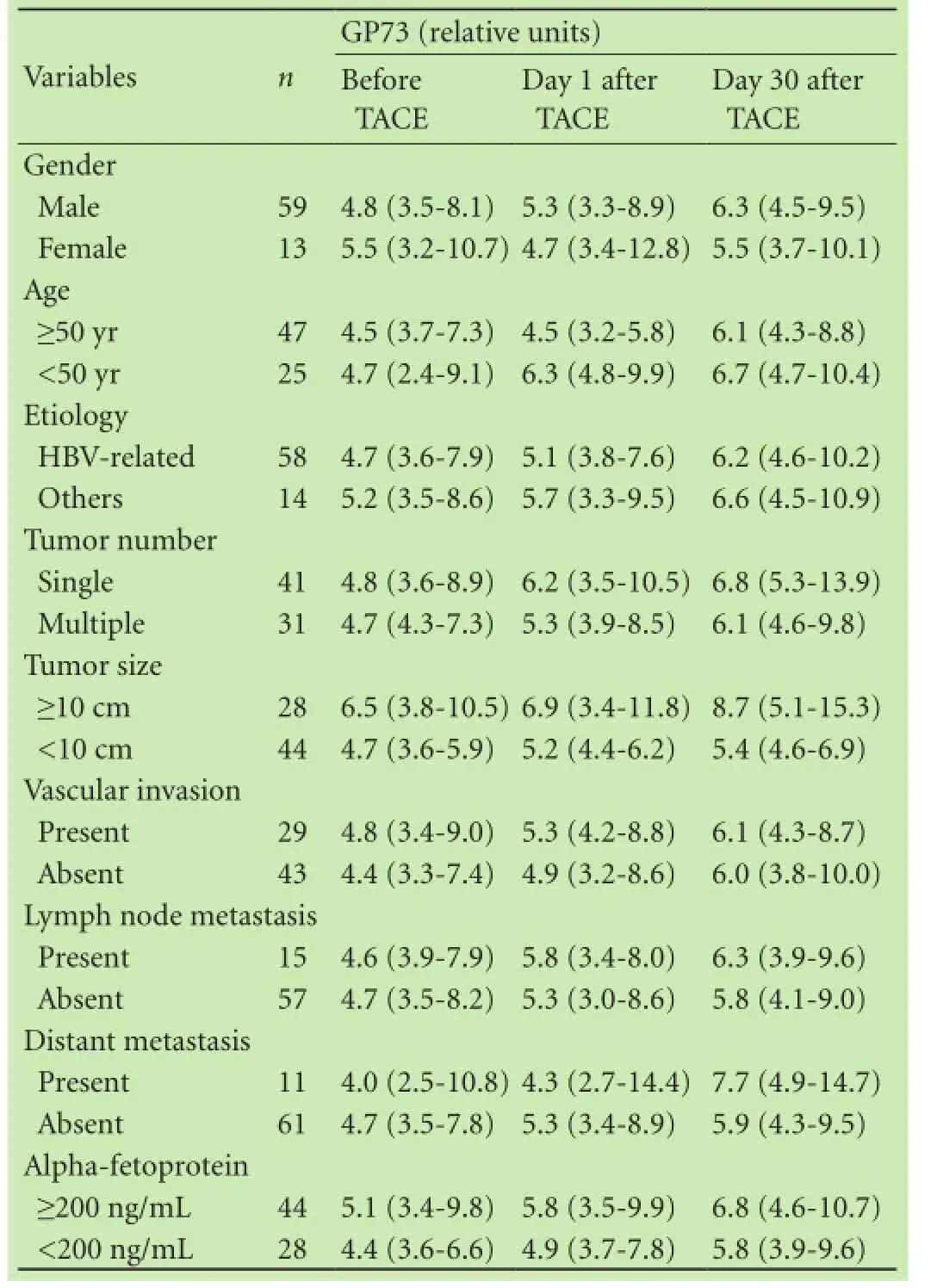
Table 1. GP73 levels in different groups of clinicopathological features
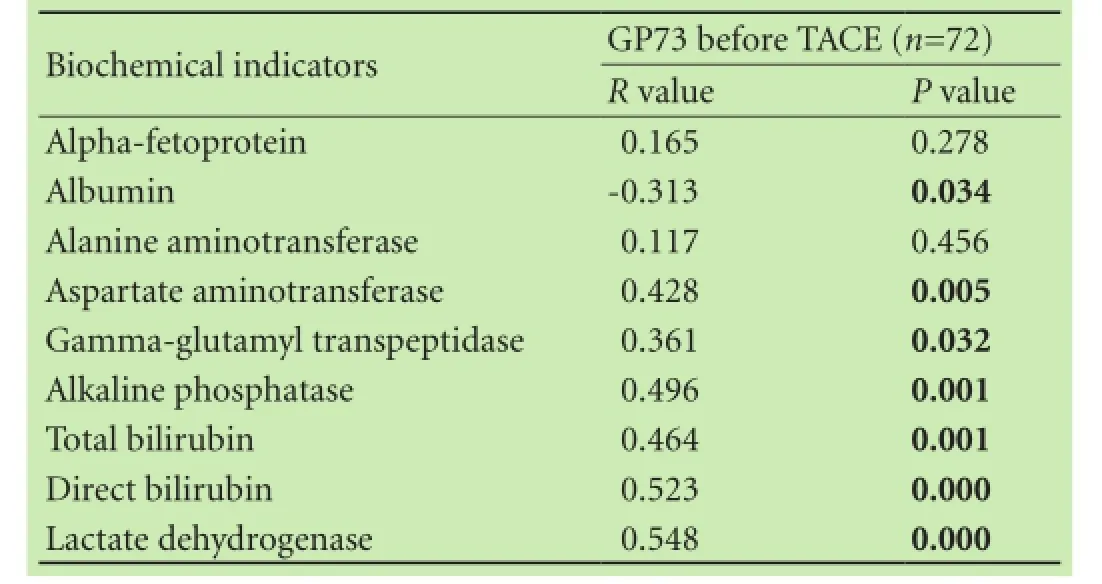
Table 2. Correlation between GP73 and biochemical indicators before TACE

Table 3. Infuence of new metastasis on GP73 after TACE
Changes of serum GP73 level and tumor responsiveness
Forty-four patients had new metastases of HCC within 17.2 months including 32 intrahepatic and 13 distant metastases and one of these patients had both intrahepatic and lung metastases. The Chi-square test indicated no correlation between the change of GP73 and new metastasis (Table 3).
Changes of serum GP73 level and survival
We divided the patients into two groups: those with increased and those with decreased GP73 at day 1 after TACE. Survival analysis showed no signifcant difference of OS or PFS (P>0.05) (Fig. 1A and C) in the two groups. This was also true for the GP73 changes at day 30 after TACE (P>0.05) (Fig. 1B and D).
Infuence of chemotherapeutics on GP73 expression in HCC cell lines
To investigate the mechanism of the increases of GP73 values in HCC patients in response to TACE treatment, we incubated three HCC cell lines with 5-FU and/or pirarubicin. We found that the GP73 levels in all the three cells were not signifcantly changed after 24-hour incubation with 5-FU at various concentrations. However, pirarubicin (20 μmol/L) signifcantly increased GP73 expression in three cell lines (Fig. 2). These results implied that pirarubicin enhanced GP73 expression after TACE.
Discussion
GP73 has been recognized as a promising biomarker for HCC. This Golgi type II transmembrane protein consisting of 400 amino acids can be found in biliary epithelial cells but rarely in hepatocytes in normal human liver.[12]However, GP73 level is signifcantly elevated in serum and tumor tissues from HCC patients.[6,13,14]Our recent multi-center, multi-nation, large sample cohort study demonstrated that GP73 decreased to the normal level in HCC patients after surgical resection, and rebounded in most of the cases after recurrence of the tumor,[5]indicating that GP73 change is an indicator of the therapeutic effectiveness of patients with HCC.
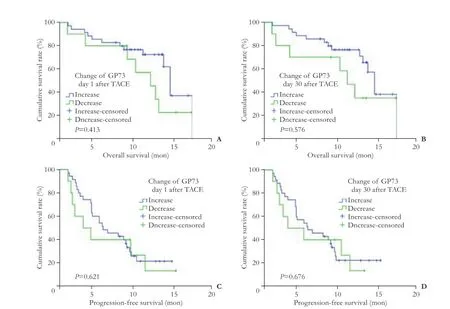
Fig. 1. Survival analysis of the patients after TACE.
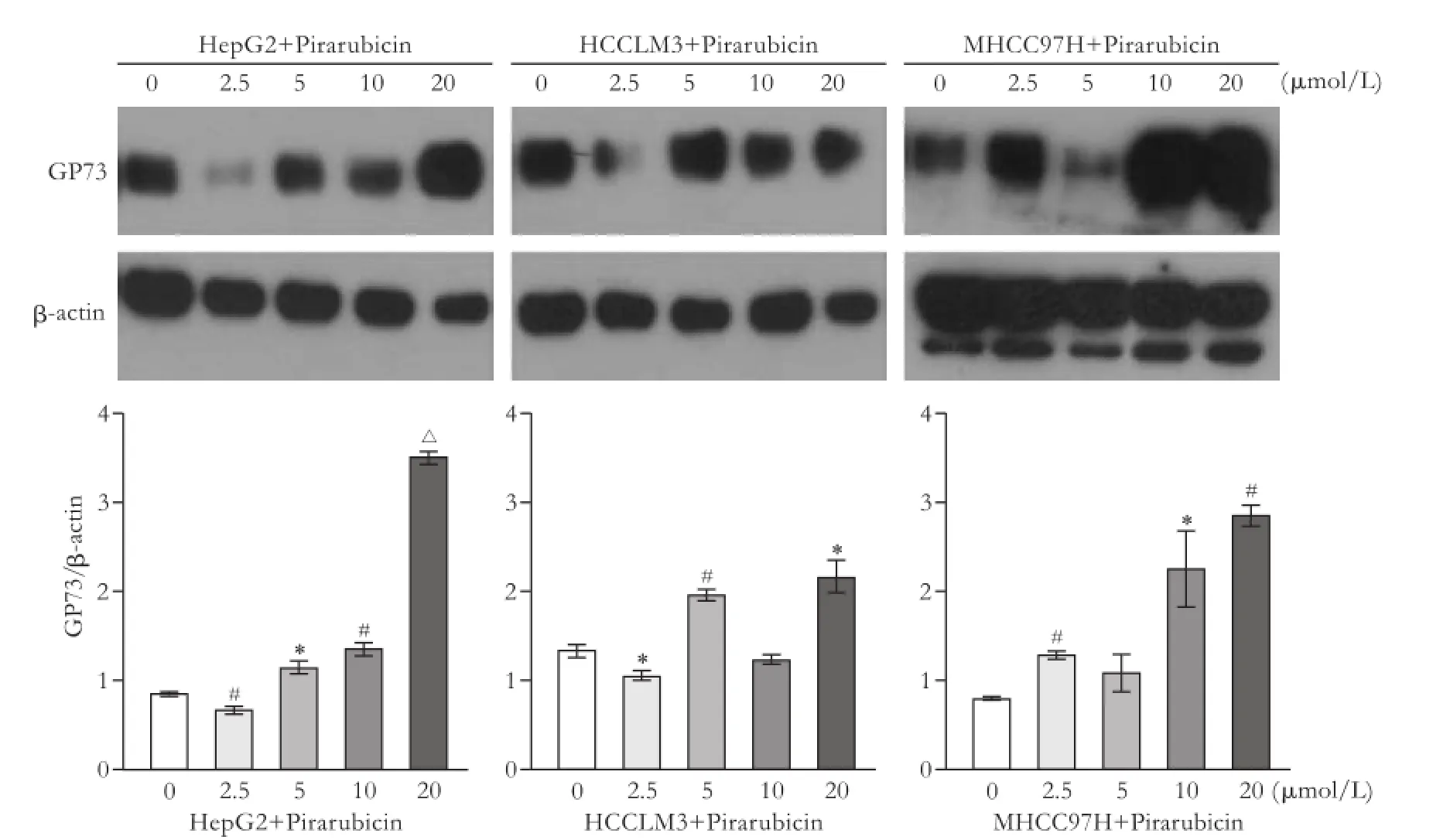
Fig. 2. GP73 expression in three cell lines with the treatments of pirarubicin. One-way ANOVA test was used to analyze the GP73 expression difference in various pirarubicin concentration treatments in three cell lines. The vertical axis of this fgure was GP73 gray value divided by β-actin gray value. GP73/β-actin values of HepG2 cells treated with 0, 2.5, 5, 10 and 20 μmol/L pirarubicin for 24 hours were 0.84±0.02, 0.65±0.04, 1.13±0.07, 1.34±0.08 and 3.48±0.07, respectively. GP73/β-actin values of HCCLM3 cells treated with 0, 2.5, 5, 10 and 20 μmol/L pirarubicin for 24 hours were 1.32±0.07, 1.04±0.06, 1.95±0.06, 1.22±0.06 and 2.15±0.18, respectively. GP73/β-actin values of MHCC97H cells treated with 0, 2.5, 5, 10 and 20 μmol/L pirarubicin for 24 hours were 0.79±0.02, 1.28±0.04, 1.07±0.21, 2.24± 0.43 and 2.84±0.12, respectively. *: P<0.05, #: P<0.01, △: P<0.001, compared with 0 μmol/L pirarubicin.
The proposal of this study was actually triggered by a question raised from the readers of our previous publication,[5]that if GP73 level could also be a potential indicator of the routine treatments of HCC other than surgery,namely TACE or sorafnib, etc. TACE is currently the frst-line therapy for unresectable HCC patients and the assessments of therapeutic effects rely on imaging and HCC biomarkers. However, both of which are neither satisfactory nor reliable. Our study aimed to observe the dynamic changes of GP73 before and after TACE.
To our surprise, the results of this study revealed that the GP73 level was signifcantly elevated, not dropped, at day 1 after TACE, and this elevation maintained up to day 30, showing that this was a real increase, not an acute reaction, by the strike of TACE manipulation. The relationship between GP73 and HCC is not clear yet. Our previous study[5]showed that surgical resection signifcantly decreased GP73 levels in HCC patients. Yamamoto and colleagues[15]showed that hepatectomy did not signifcantly change the serum GP73 levels. How to explain this inconsistency? It was reported that a majority of HCC patients in Japan were HCV-related, whereas our HCC patients were HBV-related. Another difference was found in the GP73 measurement. We used Western blotting, and Yamamoto et al used ELISA methods. Since TACE has a therapeutic effect on HCC, the elevation of the GP73 levels after TACE needs to be investigated.
We have thus performed cell culture to see if certain chemotherapeutics, particularly 5-FU and pirarubicin that we employed in our patients, contribute to the increased GP73 levels after TACE. The results showed that 20 μmol/L pirarubicin, but not 5-FU, signifcantly elevated GP73 expression in three HCC cell lines. HCC cells treated with 20 μmol/L pirarubicin were equivalent to the clinical dosage of TACE in patients. Thus we speculated that TACE might have limited effects on suppressing the GP73 level and that the increased GP73 was from the HCC reaction to pirarubicin. We also observed the changes of GP73 in 11 patients who received only transarterial embolization treatment without chemotherapy (data not show). The results showed that transarterial embolization did not change the GP73 levels of the patients. The patients' serum GP73 levels at day 1 and day 30 after TACE were signifcantly higher than those treated with transarterial embolization. These fndings indicated that chemotherapeutics (pirarubicin) increased the GP73 values.
In our study, there was no correlation between GP73 and clinicopathological features, such as gender, age, etiology, tumor number, tumor size, vascular invasion, lymph node metastasis, distant metastasis and AFP level. However, the GP73 levels were positively correlated with most of the factors of liver damage, such as aspartate aminotransferase, gamma-glutamyl transpeptidase, alkaline phosphatase, total bilirubin, direct bilirubin and lactate dehydrogenase, which indicate acute liver injuries caused by infammatory reaction following TACE treatment.
Survival analysis suggested that the change of GP73 was not related to OS or PFS, which was consistent with a previous study.[6]We believed that the follow-up time for our patients was relatively short. However, for patients with middle-advanced HCC that could not be surgically removed, it was hard to prolong the follow-up time. Therefore, GP73 may not be a suitable biomarker for the therapeutic effectiveness of TACE in HCC patients.
In summary, we frst observed the dynamic changes of GP73 in HCC patients before and after TACE, and found a progressive increase of GP73 following that treatment. Thus it might not be suitable to serve as an indicator for the effectiveness of TACE treatment. The use of certain chemotherapeutics such as pirarubicin during TACE and acute infammation and injury of the liver may cause the elevated levels of GP73.
Acknowledgement:We thank Xiang-Yang Liu who provided medical writing services.
Contributors:YHY and MYL proposed the study. PJ, ZYF, YHY, XHF and LX performed research. SXT, ZSX and MYL wrote the frst draft. ZYF and YHY collected and analyzed the data. All authors contributed to the design and interpretation of the study and to further drafts. PJ, ZYF and YHY contributed equally to this article. MYL is the guarantor.
Funding:This study was supported by grants from the National Key Technology Research and Development Program of China 2012 (BAI06B01), the National Natural Science Foundation of China (81201566), the Specialized Research Fund for the Doctoral Program of Higher Education (20121106110002) and Wu Jieping Medical Foundation (LDWMF-SY-2011B002).
Ethical approval:The study protocol was approved by the Independent Ethics Committee of Peking Union Medical College Hospital and Cancer Hospital, Chinese Academy of Medical Sciences.
Competing interest:No benefts in any form have been received or will be received from a commercial party related directly or indirectly to the subject of this article.
1 Nishikawa H, Osaki Y. Comparison of high-intensity focused ultrasound therapy and radiofrequency ablation for recurrent hepatocellular carcinoma. Hepatobiliary Surg Nutr 2013;2:168-170.
2 Wan S, Civan J, Rossi S, Yang H. Profling HBV integrations in hepatocellular carcinoma. Hepatobiliary Surg Nutr 2013;2:124-126.
3 Block TM, Comunale MA, Lowman M, Steel LF, Romano PR, Fimmel C, et al. Use of targeted glycoproteomics to identify serum glycoproteins that correlate with liver cancer in woodchucks and humans. Proc Natl Acad Sci U S A 2005;102:779-784.
4 Mao YL, Yang HY, Xu HF, Sang XT, Lu X, Yang ZY, et al. Significance of Golgi glycoprotein 73, a new tumor marker in diagnosis of hepatocellular carcinoma: a primary study. ZhonghuaYi Xue Za Zhi 2008;88:948-951.
5 Mao Y, Yang H, Xu H, Lu X, Sang X, Du S, et al. Golgi protein 73 (GOLPH2) is a valuable serum marker for hepatocellular carcinoma. Gut 2010;59:1687-1693.
6 Sun Y, Yang H, Mao Y, Xu H, Zhang J, Li G, et al. Increased Golgi protein 73 expression in hepatocellular carcinoma tissue correlates with tumor aggression but not survival. J Gastroenterol Hepatol 2011;26:1207-1212.
7 Llovet JM, Bruix J. Systematic review of randomized trials for unresectable hepatocellular carcinoma: Chemoembolization improves survival. Hepatology 2003;37:429-442.
8 Lau WY, Lai EC. Hepatocellular carcinoma: current management and recent advances. Hepatobiliary Pancreat Dis Int 2008;7:237-257.
9 Chan SL, Mo FK, Johnson PJ, Hui EP, Ma BB, Ho WM, et al. New utility of an old marker: serial alpha-fetoprotein measurement in predicting radiologic response and survival of patients with hepatocellular carcinoma undergoing systemic chemotherapy. J Clin Oncol 2009;27:446-452.
10 Kirchhoff TD, Bleck JS, Dettmer A, Chavan A, Rosenthal H, Merkesdal S, et al. Transarterial chemoembolization using degradable starch microspheres and iodized oil in the treatment of advanced hepatocellular carcinoma: evaluation of tumor response, toxicity, and survival. Hepatobiliary Pancreat Dis Int 2007;6:259-266.
11 Riaz A, Ryu RK, Kulik LM, Mulcahy MF, Lewandowski RJ, Minocha J, et al. Alpha-fetoprotein response after locoregional therapy for hepatocellular carcinoma: oncologic marker of radiologic response, progression, and survival. J Clin Oncol 2009;27:5734-5742.
12 Kladney RD, Bulla GA, Guo L, Mason AL, Tollefson AE, Simon DJ, et al. GP73, a novel Golgi-localized protein upregulated by viral infection. Gene 2000;249:53-65.
13 Kladney RD, Cui X, Bulla GA, Brunt EM, Fimmel CJ. Expression of GP73, a resident Golgi membrane protein, in viral and nonviral liver disease. Hepatology 2002;35:1431-1440.
14 Riener MO, Stenner F, Liewen H, Soll C, Breitenstein S, Pestalozzi BC, et al. Golgi phosphoprotein 2 (GOLPH2) expression in liver tumors and its value as a serum marker in hepatocellular carcinomas. Hepatology 2009;49:1602-1609.
15 Yamamoto K, Imamura H, Matsuyama Y, Kume Y, Ikeda H, Norman GL, et al. AFP, AFP-L3, DCP, and GP73 as markers for monitoring treatment response and recurrence and as surrogate markers of clinicopathological variables of HCC. J Gastroenterol 2010;45:1272-1282.
Received December 24, 2014
Accepted after revision June 19, 2015
Author Affliations: Department of Radiology (Pan J) and Department of Liver Surgery (Zhang YF, Yang HY, Xu HF, Lu X, Sang XT, Zhong SX and Mao YL), Peking Union Medical College Hospital, Chinese Academy of Medical Sciences and Peking Union Medical College, Beijing 100730, China; Department of Abdominal Surgery, Cancer Hospital, Chinese Academy of Medical Sciences and Peking Union Medical College, Beijing 100021, China (Zhang YF)
Yi-Lei Mao, MD, PhD, Professor of Surgery, Department of Liver Surgery, Peking Union Medical College Hospital, Chinese Academy of Medical Sciences and Peking Union Medical College, 1# Shuaifuyuan, Wangfujing, Beijing 100730, China (Tel: +86-10-69156042; Fax: +86-10-69156043; Email: yileimao@126.com)
? 2015, Hepatobiliary Pancreat Dis Int. All rights reserved.
10.1016/S1499-3872(15)60403-9
Published online July 17, 2015.
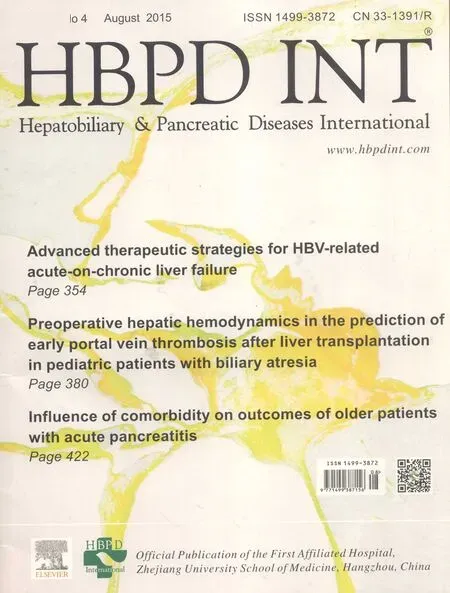 Hepatobiliary & Pancreatic Diseases International2015年4期
Hepatobiliary & Pancreatic Diseases International2015年4期
- Hepatobiliary & Pancreatic Diseases International的其它文章
- Meetings and Courses
- A liver donor with double hepatic artery aneurysm: a saved graft
- Impact of venous thromboembolism on the natural history of pancreatic adenocarcinoma
- Pancreaticoduodenectomy with portal vein/superior mesenteric vein resection for patients with pancreatic cancer with venous invasion
- Influence of comorbidity on outcomes of older patients with acute pancreatitis based on a national administrative database
- A serum metabolomic analysis for diagnosis and biomarker discovery of primary biliary cirrhosis and autoimmune hepatitis
